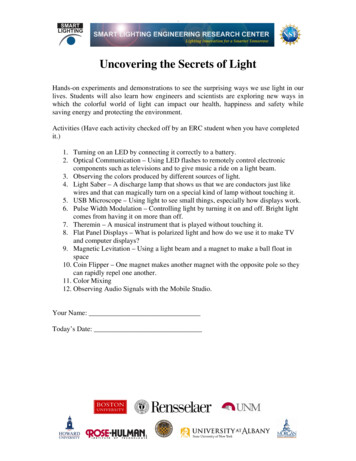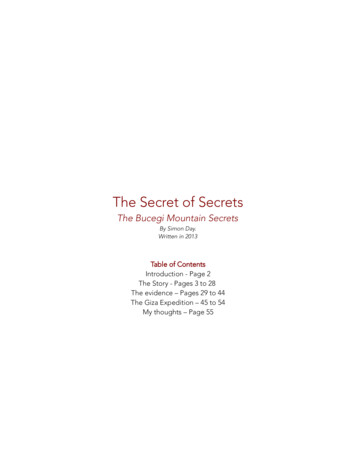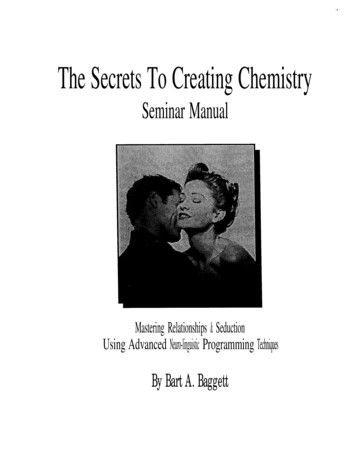
Transcription
Uncovering the Secrets of LightHands-on experiments and demonstrations to see the surprising ways we use light in ourlives. Students will also learn how engineers and scientists are exploring new ways inwhich the colorful world of light can impact our health, happiness and safety whilesaving energy and protecting the environment.Activities (Have each activity checked off by an ERC student when you have completedit.)1. Turning on an LED by connecting it correctly to a battery.2. Optical Communication – Using LED flashes to remotely control electroniccomponents such as televisions and to give music a ride on a light beam.3. Observing the colors produced by different sources of light.4. Light Saber – A discharge lamp that shows us that we are conductors just likewires and that can magically turn on a special kind of lamp without touching it.5. USB Microscope – Using light to see small things, especially how displays work.6. Pulse Width Modulation – Controlling light by turning it on and off. Bright lightcomes from having it on more than off.7. Theremin – A musical instrument that is played without touching it.8. Flat Panel Displays – What is polarized light and how do we use it to make TVand computer displays?9. Magnetic Levitation – Using a light beam and a magnet to make a ball float inspace10. Coin Flipper – One magnet makes another magnet with the opposite pole so theycan rapidly repel one another.11. Color Mixing12. Observing Audio Signals with the Mobile Studio.Your Name:Today’s Date:1
LED Circuit: Making Light with ElectronicsComponents:LED (Light Emitting Diode)ResistorWiresBattery We will now make a solid state lightSuch a light could be used to send flashing signalsThis is what traffic lights (red, yellow, green) are made from these daysThe Light Emitting Diode is an electrical component. To operateit requires electricity to power it. For our experiment, we willget this electricity from a 9Volt batteryFor this activity, you have a bag of parts and a protoboard. First, we will build a simpleconfiguration that lights up an LED. The circuit we will build is discussed on an excellentwebsite for projects. http://www.robotroom.com1. Using the protoboard, the LED and the current limiting resistor, build the circuitshown above. Include the wires you will use to connect to the 9V battery, but donot connect the battery.2. Have your circuit checked. If it is OK, connect the battery to the battery wires.Your LED should light up.2
If your LED does not light up, remove it and insert it in the other direction. If it does notlight up, you will need some help to troubleshoot your circuit.3. LEDs only permit current to flow in one direction because they are diodes. Diodeswork like a flapper valve which only allows water to flow in one direction. Thereis a flapper valve in the bottom of the tank that feeds water to a toilet, for example.Incandescent bulbs are not diodes, but are just resistors that get sufficiently hot togive off light. This makes them quite inefficient. To see that an incandescent bulbcan also work with a 9V battery and in both directions, use one of the 12V bulbsprovided with pigtail wires attached. Since the alternating current (AC) powerprovided to these bulbs has voltages that alternate between 12V and -12V 60time per second, this shows that an incandescent bulb will stay on essentially allof the time. If they were diodes they would only be on when the current flows inthe right direction. The circuit symbol for a diode and an LED are quite similar.Diode:LED:Note that the current flows to the right in both cases. The small arrows on the LEDindicate that light is emitted when the diode is on.4. Also, you can add a second LED to your circuit. First try connecting them inparallel and then in series. Do they both light up? Is one brighter than the other?Describe what you did and what you observed.3
If you look over the descriptions of LEDs onWikipedia http://en.wikipedia.org/wiki/Light-emitting diodeyou will find that it generally takes a higher voltage to turn on LEDs at the blue end ofthe visible light spectrum than at the red end of the spectrum. This is because the blue endis higher energy than the red end. Thus, when you connect two diodes in parallel, thelower energy LED should be brighter, sometimes to the point of keeping the other one offcompletely.We will now modify the circuit slightly. First, return to the circuit configuration withonly one LED.5. Now we will add a potentiometer to the circuit so that the intensity of the light canbe controlled. Disconnect the diode from the resistor, place the diode across onehalf of the potentiometer and then connect things as shown below. Your LEDshould light up again. If not, turn the knob and it should. This configurationshows us one way to control the intensity of the light from the LED.Unfortunately, it is not a very efficient way of doing this, just simple andinexpensive.R1500R2100KV19VdcD10Note: The parts distributed to you during the day are yours to keep. We need theprotoboard returned to us, but you will still be able to make the LED light up at home byfollowing the instructions found below.4
First, connect the LED and the resistor, by twisting the wires together.To light the LED, touch the metal ends of the black and red wires to the resistor anddiode. This should cause the light to turn on. Again, if the LED does not turn on, tryconnecting the wires in the other direction.5
Optical Signals: Using light to control the operation of televisions, etc. and to sendmusic through the air.Infrared Light – What is Infrared Light? It is light beyond red that is not visible to us. IRis given off by hot things. (There is also ultraviolet light that is beyond blue. UV lightgives us sun tans.) What do we know about IR light? Cannot be seen by humans Can be seen by digital camera Remote control sends IR light flashes to TV or any other device it is to controlPushing a button on a remote control causes a particular sequence of light flashes to besent to the TV or other device that is being controlled. The flashes are like a secret codethat only the TV can understand and that we cannot see.1. Using any available remote control device and a video camera, aim the remote atthe camera and observe the light flashes. Can you tell the difference between theflashes sent by different buttons? (Usually not – only the main flash can be seen.The individual flashes occur too fast to be seen by humans but the TV can tell thedifference.)2. Using the same remote control device, aim the remote at the receiver circuit forthe audio transmitter and receiver combination (diagram on the next page). Thedevice that receives the IR signal is a photo diode (it looks like an LED). Youshould be able to hear the pulses of light given off by the remote. Can youdescribe what they sound like?6
3. In the last step, you have tested the receiver. If you detected the sound producedby the remote, your receiver is working. Now you are to set up the music sourceand transmitter. Using a music source like an iPod or the audio output from thecomputer, connect the input cable for the transmitter to the music source. Makingsure that the LED on the transmitter is pointing directly at the photo diodereceiver (looks like an LED), turn on the music signal from the music source. Youshould be able to hear the music from the speaker connected to the receiver.a. Block the light from the transmitter to the receiver. The sound from thespeaker should stop.b. Move the transmitter and receiver apart. The sound should become weaker.c. Aim the transmitter so it does not send a signal to the receiver. The soundshould go away.d. Use the optical fiber to direct the light from the transmitter to the receiver.That is, place one end of the fiber by the transmitter LED and the otherend by the photodetector. You should be able to hear the music again.e. Re-align the transmitter and receiver and cover the entire experiment(transmitter and receiver) with some kind of material that blocks thebackground light from the room or turn the room lights off. The soundshould become stronger. This is because the photo diode senses theincrease in light due to the signal from the transmitter. If the room is toobright, it has a hard time seeing the light.7
Other Sources of Light: Observing the colors that make up lightLight is made up of all the colors of the rainbow from blue to red. To be able to see theindividual colors that make up sunlight, for example, we can use a simple device called aspectroscope. In the picture below, the spectroscope looks like a very small telescope.However, unlike a telescope, it has a small slit at one end that separates the colors into adisplay that looks like the visible spectrum below.1. Before we use the spectroscope to look at the kind of light sources made byhumans, we should first look at the light from the sun. Go to the nearest windowand look out the window through the spectroscope. You should observesomething like the picture above (just the colors, without all of the numbers).8
2. Next, observe several artificial light sources – fluorescent lamps, the light from acomputer monitor, light from an LED. Note that the light you observe will lookdifferent than sunlight because there are bright lines that stand out in the spectrum.An example is shown below, where a type of fluorescent lamp is seen to havemany bright lines. The lamps in the classroom will probably not produce thissame pattern.Observe at least two different light sources in the classroom and then (if you havetime) show where you observe the brightest lines by sketching them on thespectra below. If possible, it is a good idea to turn off most other light sources inthe room and to have both members of your group observe the light pattern beforeyou sketch it.9
Light Saber – A discharge lamp that looks like the light saber from Star WarsIn this device, a light beam is caused to move up a glass tube when the person holding thehandle connects the two metal contacts with their thumb or fingerTo make this more interesting, and to show that we are all good electrical conductors,each group of six will all hold hands and form a circle with the people at the end eachmaking contact with one of the metal contacts. The length of the light beam is determinedby how good the contact is, so having many people in the loop will probably make thebeam rather short.Each student should, thus, try to turn the beam on by themselves and then see if it islonger or shorter. The red beam is neon and the blue beam is argon. Once the beam is asbright as possible, it can be observed through the spectroscope.10
Bring the light saber close to the floor lamp without touching it. About one meter ofseparation is good. Turn on the light saber and you should also see the floor lamp turn on.This happens because the lamp is electrically very noisy and the floor lamp is a touchlamp. Touch lamps turn on when you touch them because you are acting like an antennaand you pick up electrical noise from the air. To act like an antenna, you much be aconductor, but we have already shown that we are conductors by holding hands andturning the light saber on.Extra Activity – To see what kind of a conductor you are, use the DMM to measure yourresistance. Hold the tips of the mini-grabber connectors between your thumb and indexfinger on each hand. Write down the value of the resistance of the members of yourgroup.11
USB Microscope – Using a smart lighting, computer-based microscope to see smallthings.The USB Microscope is capable of seeing some very small images with and without theillumination provided by an array of several LEDs. When using the microscope, tryimages using room light alone or light from the object being imaged in addition to lightfrom the array. It should be possible to appreciate the smart nature of the imaging controlsince you will be able to see the device adjust for the light source. For each of theimaging activities below, describe how you set it up and what you observe.1. Begin with a classic imaging exercise and observe both sides of the US penny andcount the number of images you can find for Lincoln.2. Next, observe one of the clear LEDs you have been using in your circuits. You shouldlook at it from the side (as in the image above) and from the top (if the LED is on, thelight would be shining directly into the microscope). Your goal should be to betterunderstand the internal structure of a standard LED. This should be done with theLED off. However, once you have completed this, power up your LED and see if youcan observe it using only the light produced by the LED. You will have to make itvery, very dim or it will wash out the image. This requires the use of thepotentiometer or the PWM setup. Note – this is difficult to do, so do not spend a lot of12
3.4.5.6.7.time working on it. Your goal should be to get an idea of where the light is emittedfrom the LED.Using the LED array, observe the spinning top with the diffraction gratings on itssurface (these produce the rainbow colors).Using a display device (the LDC display on your computer, the display on your cellphone or MP3 player, etc.) try to expand the image sufficiently to see the individualpixels in an image. Look at a region that displays as white, red, green and blue ifpossible.Observe some part of the Mobile Studio circuit board.Observe some part of your body – hair and skin can both be interesting.Once you have completed the tasks above, try imaging something else. Use yourimagination.Some of the objects imaged:Examples of images taken with this USB microscope can be found athttp://hibp.ecse.rpi.edu/ connor/SmartPowerandLight/Dino%20Images/13
Pulse Width Modulation – How we fool our eyes into seeing different brightnesswhile turning an LED on with exactly the same intensity. Also, how to mix colors tomake a new color.In this activity we see how we can flash an LED on and off to make it look bright anddim. The light is pulsed. The longer the on pulse and the shorter the off pulse, the brighterthe light. Try different pulse widths to see this effect.Also, if the light flashes more than 30 times per second (30Hz) we cannot see the lightflash. Our eyes do not respond fast enough. To see the light flash, slow it down to 10Hzor less (1Hz is best) and you will see the light does indeed flash. Also, you will see thatthe two LEDs flash alternately so that when one gets brighter the other gets dimmer.Movies and television images appear to move smoothly because they flash faster than wecan see.If the PWM Slider executable is not already installed on your computer, download itfrom http://mobilestudio.rpi.edu/Downloads.aspx You will find it at the bottom of thepage.Build the two LED circuit on your protoboard rather than connecting the LEDs directly tothe Mobile Studio Board as shown above. You will need two LEDs and two currentlimiting resistors (the ones you used in earlier activities). You will also need 4 jumperwires. In this circuit, D2 will turn on whenever the PWM1 voltage is high and D1 willturn on whenever the PWM1 voltage is low. Thus, the LEDs will alternate being on andwill have complementary duty cycles. When the duty cycle for PWM1 is large, the dutycycle experienced by D1 will be small.14
3.3VPin2PWM1R1400R2400D1D2Pin4Pin11. Verify the information provided above by trying different frequencies and duty cycles.You should be able to observe that that this is an effective way of mixing colors.2. Once you have explored the various operating conditions with the PWM Sliderexecutable, repeat using the Mobile Studio Desktop. That is, close the PWM, openthe Mobile Studio Desktop and click on the Digital I/O option. You should see adisplay that looks like that shown below.15
Click on ‘Start All Channels’ and then adjust the parameters of the pulse widthmodulation. You will have much more precise control of conditions this way so youshould be able to better determine how fast you can see the LEDs flash, for example.3. If you have time, you can connect an LED with its current limiting resistor to one ofthe digital I/O pins and to the digital ground. Then you can turn the LED on and offwith by clicking the corresponding button (green is on).Note that in this activity, the ground is the digital ground, which is the first pin nextto the earphone jack on the digital side of the board. This is labeled on the RED2board but not on the plastic cover. It is best not to mix the digital and analoggrounds on the Mobile Studio Board.16
The Theremin – Maybe the strangest musical instrument ever madeIn this activity we learn how sensors, like airport metal detectors, can sense that we arenearby. You can control the volume and pitch of this musical instrument by bringing yourhands close to two metal electrodes. When you do this, you become part of the electricalcircuit (a capacitor, actually), which changes the way it operates. In an airport metaldetector, any metallic object you have will change the inductance of the circuit, butotherwise the effect is the same.This instrument works by creating a beat frequency between two pitches that are too highfor us to hear. (They are a little less than 300,000Hz) The difference in pitch is very small,so we can easily hear it.Instruments similar to this are used by many music groups. It is also used in sciencefiction movies to make weird and scary noises.1. The left electrode is volume control and the right electrode is pitch control. Your firsttask is to explore the sounds you can make with this device, how close you must be tothe electrodes, etc. Basically, just have fun with it and then write down a descriptionof your experience.2. This device works by adding capacitance to the circuit by placing our hands near theelectrodes. Any two conductors make a capacitor. In this case, our hands are one ofthe conductors and the electrodes are the other. Given the expression shown on thenext page for the frequency of the oscillators in the circuit, can you determine howmuch we have to change C to increase this frequency by 1000Hz so we can hear atone of 1000Hz?3. Go online and look for information on the Theremin. Definitely look at YouTube towatch a video or two of people playing this interesting instrument.17
Shown above is the basic idea behind the Theremin, where the capacitance fromone’s hand is added to a resonant circuit. The full circuit diagram is shown below.The circuit resonates at a frequency given by18f 12π LC 1 286kHz2π (94 μH )(3300 pF )
Flat Panel Displays – How polarized light allows us to make Liquid Crystal DisplaysWork.LCD displays use light polarizers like the ones we use for sunglasses and 3D displays toturn small dots of colored light on and off. To see that there is a polarizer in such adisplay, place a polarizing filter over a flat panel display and rotate it until the image goesaway. Also use two filters to see the same effect.Describe what you observe when you place the polarizing filter over the LCD display onthe computer you are using. You will have to rotate the filter. Discuss the operation ofLCD displays in your group and with one of the ERC students.19
Magnetic Levitation – Using a light beam and magnet to make a ball float in spaceIn this activity, you should try to get the magnet to levitate the ball. Remember that youhave to keep your fingers out of the beam of light, otherwise you will block the lightsensor and the system cannot work. This is an example of a smart system that can do ajob for us without us doing anything, at least once the ball in floating. The light beam isIR so we cannot see it, but we can definitely feel the magnet once the light beam tells it toturn on.1. How much of the IR beam do you think you blocked when you succeeded in gettingthe ball to levitate?2. Use another light source to see if you can interfere with the IR beam. Be sure not toblock the beam, only try to increase the background light signal in some way.3. Using any other magnet (permanent magnet, electromagnet), try to suspend amagnetic object below it without touching the object. Is it possible to do this if youcannot independently control the strength of the magnet?4. This is an example of negative feedback. Can you identify at least one other exampleof negative feedback in some every day device? You may want to look online forsome ideas.20
Activity #10Coin Flipper – Using one electromagnet to repel anotherIn the maglev activity, we saw that a magnet can put a force on a ball that pulls the twoobjects together. There is a second kind of magnetic force that pushes things apart. Thesecond force happens when one electromagnetic makes currents flow in anotherconductor (called eddy currents). The current in the second object also forms anelectromagnet, but with its poles pointed in the opposite direction. Since north poles repelnorth poles and south poles repel south poles, the two magnets will repel one another.There is sufficient force produced to launch objects at high speed. In this case, we launchcoins and similar disk shaped objects. Also required for this force is that the disk be avery good conductor but not magnetic. If it is magnetic, it will be both attracted andrepelled and little will happen.We can measure the speed of the coin using light, but that is not yet included in thisactivity.1. Try several different coins and other conducting objects. Which ones were launchedthe best (fastest, farthest, etc)? Which ones did not move much at all?2. Launch a ping pong ball using a copper ring. Obviously, it is the ring that is beinglaunched and it transfers its momentum to the ball by pushing on it.21
Using Light to Show Motion – Moving Magnet Makes LightIf we drop a strong magnet down a pipe and wrap a coil of wire around the pipe, we willbe able to generate electricity. This is the same principle used by the big electricalgenerators at places like Niagara Falls. (The water going over the falls causes themagnets to move).Drop the magnet down the plastic pipe and watch the LEDs light up as the magnet passesby.22
Magnetic BrakingWe have seen with the coin flipper and the magnet dropping through a copper coil, that achanging magnetic field can produce a current in a nearby conductor. For the coin flipper,the changing field occurs because the current that produces the field changes rapidly withtime. The permanent magnet dropping through the coil has a changing field because themagnet itself is moving. In this exercise, we will observe the differences when we drop amagnet down a plastic pipe and a copper pipe. One will go rapidly and one will be quiteslow.1. Drop the magnet down the plastic pipe and measure the time it takes to fall from oneend of the pipe to the other. There is a good online stopwatch to make thismeasurement at tch/ Calculatethe time to drop and then compare it to your measurement. Drop it on the carpet toavoid making noise or damaging anything. From basic Physics:at 2 gt 22hh or t g 9.8 m 2s22g2. Now drop the magnet down the copper pipe and measure the time.3. Also try sliding the magnet on the copper plate.Describe what you observe.4. Now describe how you might use this effectto make a brake for a car or truck.Copper pipe with strong magnet falling through itPlastic pipe with the same strong magnet23
Mixing Colors – White light is made by mixing red, green and blue light. To see this, goto the web site http://www.omsi.edu/tech/colormix.php where the following figure isfound:1. Once at this web site, the slider controls at the lower left hand corner can be used toincrease or decrease the amount of red, green or blue light in the figure. With all threeat their maximum intensity, they combine to make white light. Use the slider controlsto see what colors you can make with red plus green, red plus blue, blue plus green,and all three.2. Compare your experience mixing colors using this tool with what you were able to dowith two LEDs and Pulse Width Modulation.24
Observing Audio Signals with the Mobile StudioIf there is time, you can see how sounds look when they are observed as electrical signals.We have already looked at signals in the audio range, but now we want to start withsomething that is a recognizable sound. For this exercise, you will need a cable thatconnects from the audio (earphone) jack on the computer to the Mobile Studio Board.This has a standard plug on one end and three wires on the other. Connect one of theplastic coated wires to channel one on the scope (pin 1) and the other to channel two (pin4). The uncoated wire is the ground so connect it to one of the ground points (pin 2). Nowset up the Oscilloscope in the Mobile Studio to measure signals from A1 SE and A2 SE.Set the time per division to be 1ms. This you should change later on, but this is a goodplace to start. Start the measurement. If the signal is too large or too small, change theloudness of the signal from the computer and the voltage scale on the Mobile Studio untilyou see the signal clearly.1. Observe the signals on the two channels (the two stereo channels for the audio) as themusical piece changes. You will note that it is not possible to hear the signal andmeasure it at the same time since the audio output from the computer is sent to theMobile Studio.2. The designers of the Mobile Studio (Don Millard and Jason Coutermarsh) realizedthat we would like to be able to hear signals while we measure then. Thus, they addedanother feature. Click on Audio, make sure it is enabled, then use either earphones inthe earphone jack or a speaker connected as we did previously to hear the signal. Youwill have to be sure that the audio source is selected to be ADC1 and ADC 2 for thetwo channels.3. Finally, download the smaller of the two files foundat http://hibp.ecse.rpi.edu/ connor/SmartPowerandLight/Audio/ which is a recordingof the sounds produced by the TVBGone remote control which can shut off any TVsold in North America. Once you get that working, you can download the longer file,which has the complete signal from the remote. Now you can listen to this signal andwatch it on the Mobile Studio. What kind of a structure do you see to the signal? Canyou see how it is able to send coded messages to electronic devices like TV sets?As usual, please write down your observations while you do this experiment.25
Other InformationExample of IR remote image in digital cameraYouTube ResourcesShowing the IR light from a remote.http://youtube.com/watch?v Lf769YVZ7MEhttp://youtube.com/watch?v U UE3s9edVohttp://youtube.com/watch?v WUF8 3uPNNUWhat is Infrared? (from NASA)http://youtube.com/watch?v 2--0q0XlQJ0Examples of LED Circuitshttp://youtube.com/watch?v eqId7g7SC10http://youtube.com/watch?v Q4Oz BXcbz0&feature relatedLight Displayshttp://youtube.com/watch?v 9hjtd eEmA (42000 holiday lights)http://youtube.com/watch?v KZZC2NFUkZA (CN Tower in Toronto)LED Traffic Lightshttp://youtube.com/watch?v yAAbsy15OLoLED Light Bulbshttp://youtube.com/watch?v XTIgDq2a-1A&feature relatedInteractive LED Coffee Tablehttp://youtube.com/watch?v IkmpIXd9Q90&feature related26
computer monitor, light from an LED. Note that the light you observe will look different than sunlight because there are bright lines that stand out in the spectrum. An example is shown below, where a type of fluorescent lamp is seen to have many bright lines. The lamps in t










